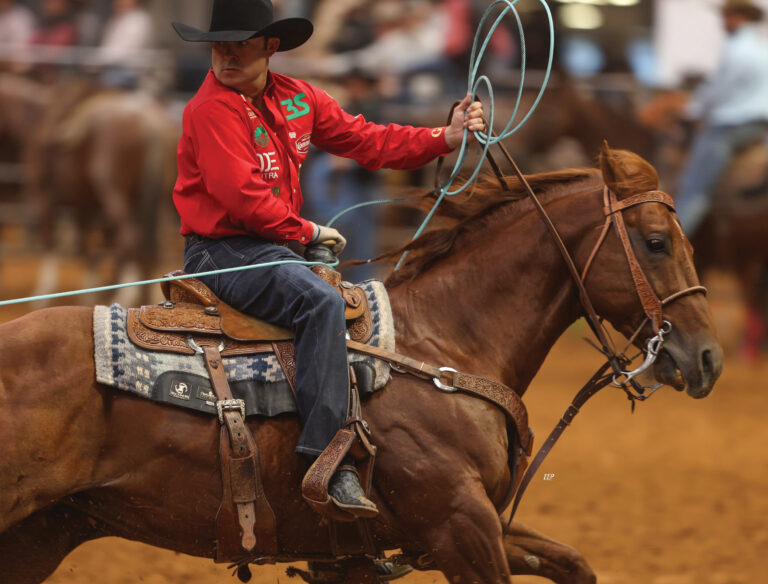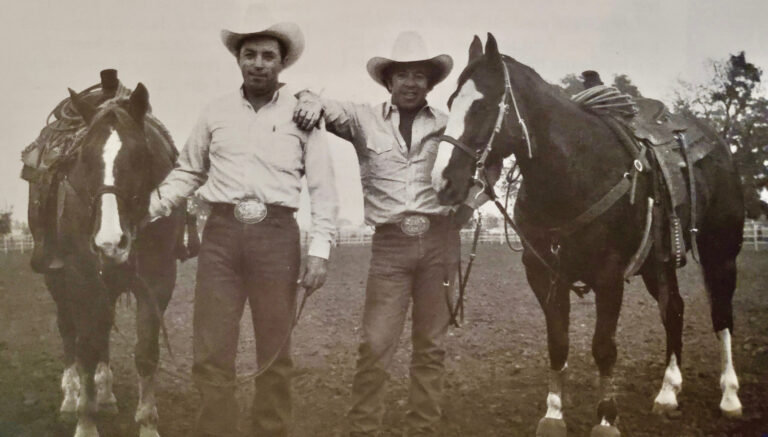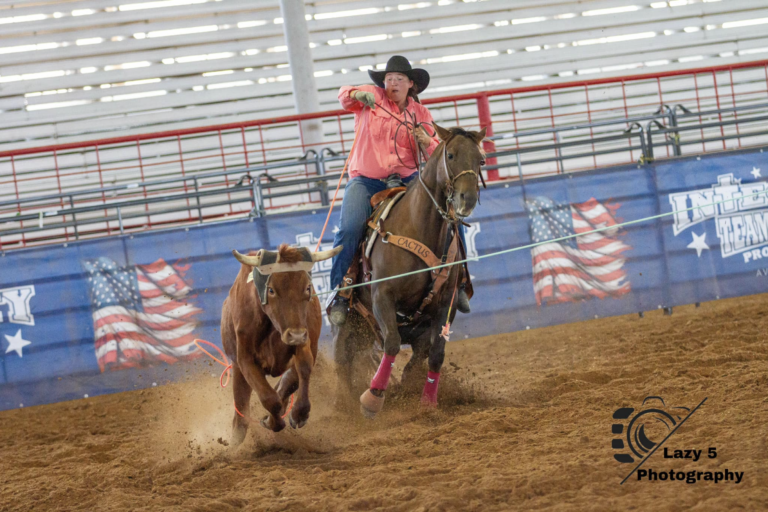The toughest ropers in the world, back when Michael Jackson was moonwalking and Apple was promoting its first computer, knew squat about bloodlines. But even then, according to Hall of Famer Tee Woolman, all somebody had to say was “Harrison horses” and they knew they were good ones.
Quietly, for almost 90 years, the Harrison Ranch has produced some of the best rope horses in the world. Over the past few years, those include (to name just a few) the heel horse on which Steve Purcella split a $178,000 Finale check, the head horse turned 2023 AQHA/PRCA Steer Roping Horse of the Year, the defending Head Horse of the Mike Cervi Jr. Memorial Pro Classic and the champion heel horse of the #13.5 at the latest Cinch USTRC Finals.
Most breeders whose babies grew up to chase NFR steers in the 1970s aren’t also responsible, presumably, for the maternal line of current greats like Time To Glo, the team roping stallion that earned $132,187 last year as a 4-year-old.
So, how does a program that started in the 1930s still have such a major influence?
It has to do with Texas tycoons, the strategic cowboys that worked for them and some unbelievable mares.




Oil and cattle
Daniel Harrison, according to a 2014 Forbes article, in 1903 started building the family’s oil and ranching empire across West and South Texas. With large spreads, including one near Catarina that grazed 30,000 head of cattle, he needed to supply plenty of ranch horses.
Harrison started breeding them on his ranch near Sonora before the AQHA was even established. He was later joined by his son, Dan Harrison Jr., and in 1952, the Harrisons tapped Jesse Gonzales to run the overall horse program at their ranch in Fulshear, just west of Houston.
The program was anchored by King and Old Sorrel blood, including a 1959 grandson of both called Les Glo. He was a big, strong stallion that hadn’t been broke to ride until he was at least 7 years old. Then Gonzales started cutting on him and he became the 1968 AQHA champion. Soon, the outfit began breeding Les Glo daughters to popular studs like Colonel Freckles and Docs Sug.
“When you saw a rope horse with that TYT brand, you didn’t know if you could ride him, but you knew he’d be big and strong and fast,” said nine-time NFR heeler Tyler Magnus.
Les Glo descendants could be a handful. To create that particular stallion, someone had crossed King (son of a Mexican racehorse) with a half-Thoroughbred King granddaughter (Hyglo) and bred the result, King Glo, to a granddaughter of Old Sorrel—a stallion with great cow sense. The Gonzales family, three generations strong, stuck to those attributes in their breeding decisions and put the reins in the hands of the right buyers.
“Those were cowboy horses,” recalled Hall of Fame header John Miller, who showed horses in Texas in the 1970s. “And those Gonzales boys were cowboys.”

Putting out unicorns
Gonzales’ four sons Jesse Jr., Joe, Robert and Richard all helped their dad make horses starting in the 1970s, and they also had sons and daughters who roped. John Philipp, who’s been ensconced in the team roping universe for a lifetime, helped Jesse Jr. show the rope horses starting in the late ’70s. At one time, he said Harrison horses were simply the best out there. He still recalls hearing the legend of how Gonzales Sr. only hauled Les Glo to three cuttings—the Fort Worth, San Antonio, and Houston stock shows—and the horse won all three before they kicked him out to breed.
One of the stud’s best daughters, Les Glos Sue, had King/Old Sorrel blood on both sides and was phenomenal in every event. There used to be a photo of her brother on a wall in the home of Barry Burk, the late Hall of Fame calf roper who also headed at the 1968 NFR. That horse could get back on the end of a rope as easily as he could clock a 19-second pole bending run or win a reining pattern. Horses with that kind of blood aren’t easy to find, Philipp said.
“They were real quick-footed,” he added. “That Les Glo had a big foot and big bone. But he was super athletic. Anything that had Les Glo in them at that time were a little watchy on the ground, but the colts were never real fractious about the box. I had one they’d roped a few calves on; I rode him two weeks and hauled him to a team roping jackpot. That’s how quickly they made. Probably the best head horse I ever rode was out of a Les Glo mare by a War Leo stud.”
Incidentally, today’s all-time leading dam of multiple futurity winners was also out of a Les Glo/War Leo granddaughter. Look At Her Glo’s breeder, Bobby Lewis, was impressed enough with her mother, Leo Night Glo, that he bought an entire herd of mares just to get her.
Looks matter

For the Harrison Ranch, the Gonzales crew also raised a gray stud named Skipastarsky by halter horse Skipa Star out of a King/Old Sorrel mare that became the 1983 AQHA High Point Jr. Heel Horse. Gonzales Jr. won team roping jackpots on him as a 4-year-old.
“My dad was a master at selecting the right mares,” said Jesse Gonzales III, who goes by “Jr.” He also helped ride Harrison horses in the 1980s, and his sister, Becky Gonzales Cook, worked for the Harrisons until 2013. “His cross with Skipa Star was just to refine their looks. He had a steadfast belief that those Harrison mares could be bred with any stud and still produce remarkable offspring.”
Philipp wasn’t as enamored of that line, but said he sold one to Marc Stureman that Gary Poythress won Salinas on. Skipastarsky threw big hips and pretty heads on his offspring; his dam, King Moores Dora, was said to be a tough ranch mare with a big heart. Two of Skipastarsky’s offspring were Bryan Fields’ Ima Star O Lena, the 2003 PRCA Steer Wrestling Horse of the Year, and One Black Starsky, the super-stout 2000 NIRA Steer Wrestling Horse of the Year that kick-started the career of Hall of Famer Luke Branquinho.
The Harrison Ranch’s goal for decades was to breed for versatility, and one of their most magic crosses resulted from a Les Glo mare on Colonel Freckles.
“I jackpotted around a lot of those Les Glos Colonel horses, and they were all massive and just so fast,” Magnus recalled. “Some of them were kind of hot, but they were just so athletic for as big as they were. And they were all pretty—real clean throatlatches and mostly bays and grays. They were big, fast and pretty.”
Bob McClelland rode the Harrison-raised Skipa Red Glo at the 1991–92 NFRs in team roping. George Strait reportedly bought a couple Harrison horses over the years. In fact, about 23 years ago at one George Strait Team Roping Classic, three horses off of the Harrison Ranch placed in the average, according to Jesse Jr.’s son-in-law Jeff Cook. They were so good-minded that 14-time NFR heeler Monty Joe Petska could visit Fulshear, climb on a colt with just days of riding and beat everybody in an informal donkey roping.
“I remember hearing that the Harrisons never kept a broodmare unless she had AQHA points,” marveled Petska, who heeled at NFRs on two different Harrison horses. “When I first went there, I saw like 120 mares. It was like going to the candy store to look at all those awesome colts.”
He figures he rode about eight colts out of Fulshear over the years, all quality horses.
“I had a bay I called Rayman and so many people tried to buy him and wanted to know what he was,” he said. “You just don’t get that style horse anymore—big bones, big butts and big bodies but still quick-footed and athletic. Cory [Petska] rode Rayman twice and won like $35,000.”
Strategic decisions

When Jesse Sr. relocated to manage another Harrison spread in 1974, Jesse Jr. became the equine manager at Fulshear.
“The first Jesse Gonzales kind of put it all together for the Harrisons,” Philipp said. “And his boys were raised in the middle of those horses. I couldn’t believe how good those horses were.”
Jesse Jr. ran the Harrison equine operation for more than 40 years and his brother Richard broke thousands of colts in the Fulshear round pen. When he returned from Vietnam, Richard joined the 15 or so cowboys clearing Harrison’s 127,000-acre ranch outside Catarina of maverick bulls. Gonzales was delighted to spot a black mare in the string that he’d started back at Fulshear.
That ranch was adjacent to the famous Light Ranch where Phil Lyne was hanging out, since his wife was raised there. Lyne, one of the most decorated rodeo cowboys of all time, got Gonzales into steer roping. That’s when Richard—the biological father of Hall of Fame roper Cody Ohl—took that black Harrison mare to the NFSR as a PRCA rookie in 1980 and again in 1990 when she was 24. Lyne also rode a tough Harrison horse, and Slade Wood’s Son Ofa Doc (by Doc Acre Glo) was the 2023 Steer Roping Horse of the Year.
Clearly, Harrison horses were always in demand. But Jesse Jr. was very selective about who could show up at Fulshear and buy a colt. Not just anybody could walk in there and get one, said Philipp.
“Jesse had to call you,” he remembered. “If you didn’t go through him, nobody was doing any business. That’s the way it was. Jesse made sure he knew where those horses went.”
Many went was to other giant remudas in Texas. Guys like Buster Welch and the Bramans brought mares. The King Ranch sent several mares to Fulshear to be bred to Les Glos Colonel. Today, King Ranch’s stud Coronel Del Rancho—the 2021 World Champion All-Around Junior Horse at the Versatility Ranch Horse World Championships—is out of the Les Glos Colonel daughter San Gris Girl, whose 4-year-old son recently won the King Ranch’s entire colt competition.
“Those horses could run,” Philipp said. “It was kind of a cutting horse that was the size of a head horse. You didn’t see those big mares even back then. Most cutters weren’t big enough or didn’t have enough foot or bone about them. But Les Glo, he produced so many horses standing 15.1 and weighing 1,250–1,300. Big, athletic horses.”

Today, the phenomenal mares that once grazed under the oak trees at Fulshear have been relocated. According to Forbes, the late Dan Harrison III sold the Sonora ranch to Meridian in 1990 for eight figures and leased much of the Catarina ranch to Shell in 2010 for 10 figures. But his wife, Rosemary Harrison, still raises cattle on her ranch near Cuero and still keeps the family horse legacy alive, 48 years and counting.
After a 75-year run, the Gonzales family is out. The current manager of Harrison Horses, barrel racer Tyler Rivette, is phasing the program solely into the barrel racing industry. It’s lucky for team ropers, then, that sly breeders like Lewis and Philipp have held on to key mares with Harrison breeding. The Philipp Ranch still breeds a few mares wearing the TYT brand on the left hip, with a production sale Sept. 7, 2024, in Bryan. And the King Ranch will offer a 3-year-old out of San Gris Girl in its Return to the Remuda sale, also in September.
Thus, some Harrison influence remains, more than 50 years after Les Glo gave team ropers size and speed to go with intelligence and cow.

—TRJ—












